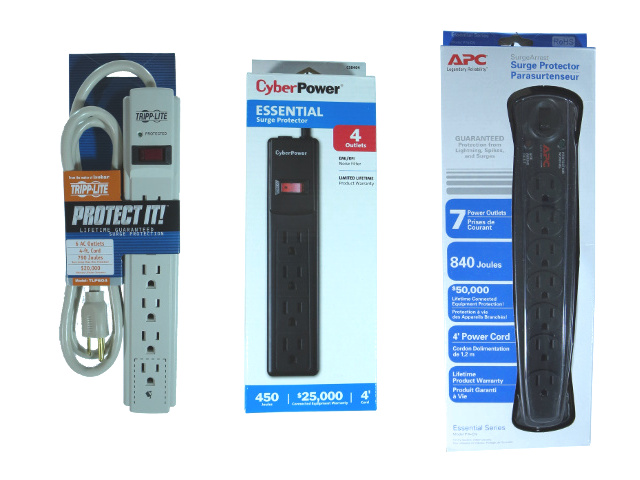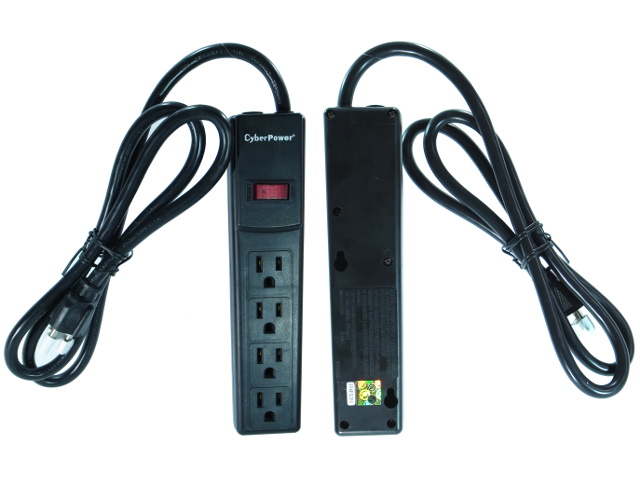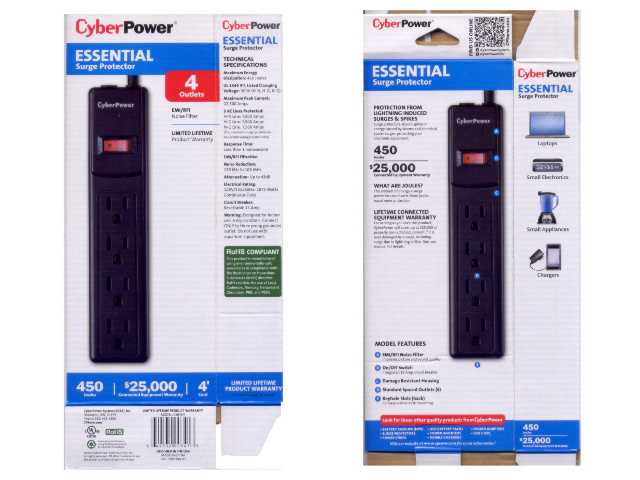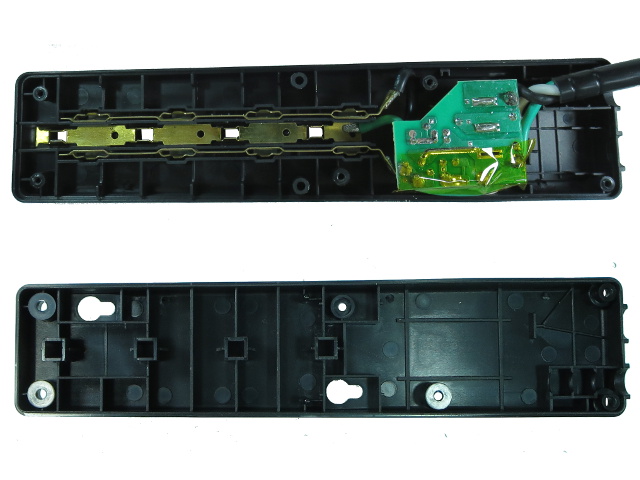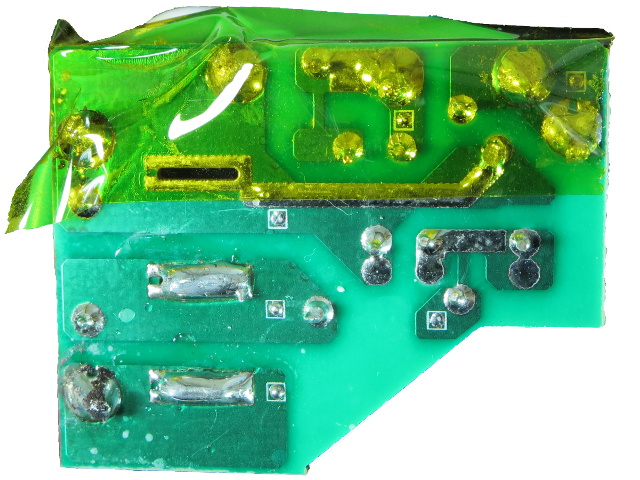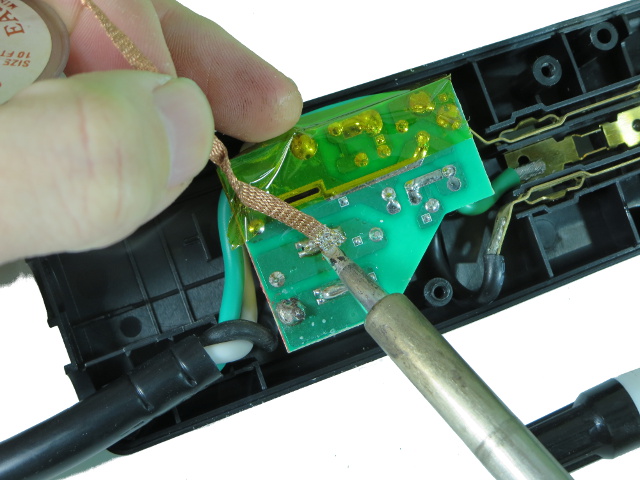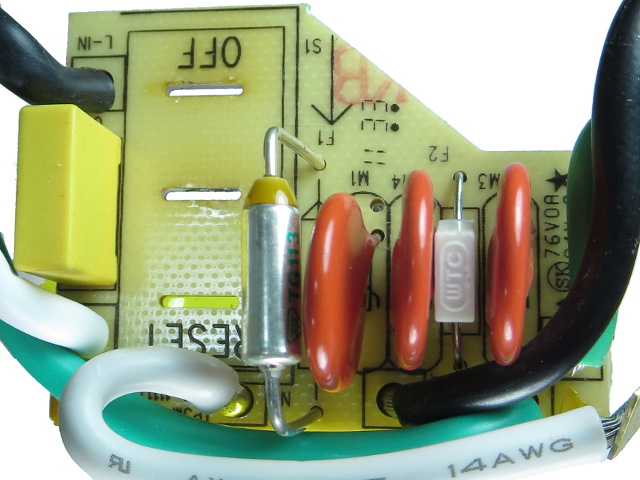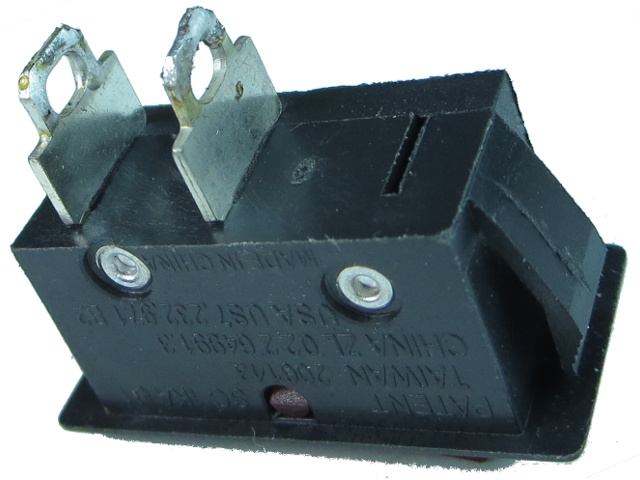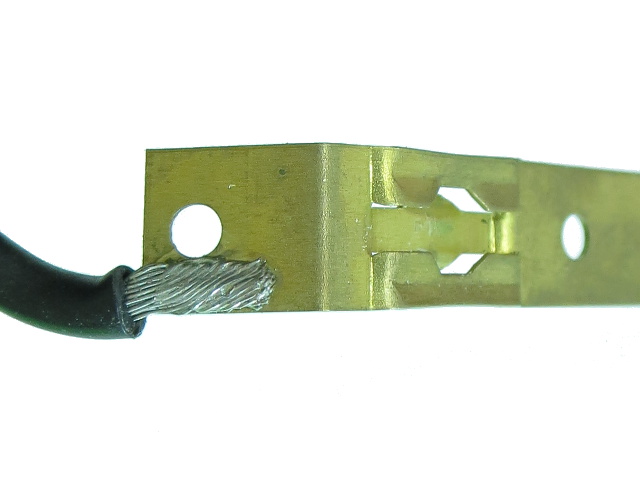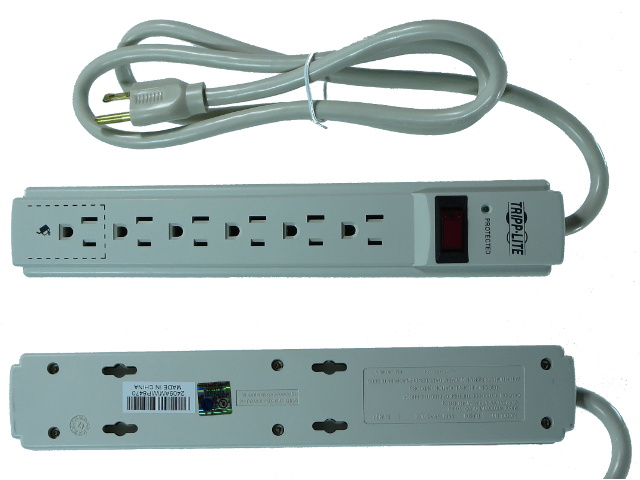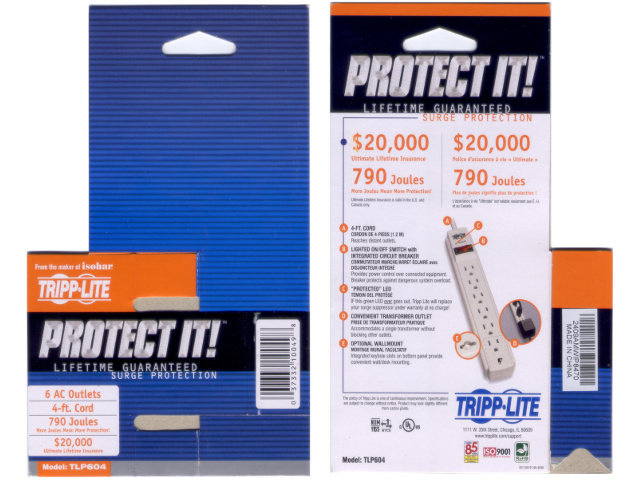Let's Take a Trip Inside Budget Power Bars, Part Three
In this third and final part of this series, we take a look at three units from some of the most popular brands in IT-related power products. All of your patience is about to pay off: we're also picking an overall winner.
Round Three: The Usual Suspects
Our laundry list for today features the following:
- TrippLite's TL604, $11
- CyberPower's CSB404, $10
- APC's P74-CN, $12
Those prices were valid when I started putting this article together. All three models have gone up by a few dollars, likely to pad margins on Thanksgiving and Boxing Day discounts.
Overall expectations are much higher in this third round. Let's get to it, shall we?
Our Seventh Contestant: CyberPower's CSB404
The smallest unit, sporting only four outlets, CyberPower's is also the only one with a rubbery cap on its power plug. Aside from the UL sticker, writing on the back contains the usual dry-location and no daisy-chaining warnings, along with the 500V surge suppression rating across any two conductors.
I would have preferred to get the CSB604, which was only $1 more, for this tear-down. But it would not ship from the same NewEgg warehouse as the other four, so I picked the CSB404 as a stand-in.
CyberPower's Packaging
CyberPower's front packaging is easily the most barren of the three bars, with little more than than the brand, product name, image and basic features. The unit promises a $25,000 protection warranty with 450J worth of surge suppression. Its side panel adds that the suppression can handle surges up to 7500A and mentions some degree of noise reduction from 150kHz through 100MHz.
Inside The CyberPower
Once again, we are greeted with the familiar outlet and metal strip arrangement. Here, though, we find a PCB soldered top-down on the breaker switch, which has only two terminals. It lacks the neutral connection an illuminated switch would require for power.
Get Tom's Hardware's best news and in-depth reviews, straight to your inbox.
CyberPower's PCB
The soldering looks about as good as it is going to get. Getting a nice solder joint on thick metal tabs can be difficult, and part of the reason why they look crooked is because the breaker's tabs have been bent slightly to prevent it from popping off the PCB during soldering. The live and neutral switch islands come awfully close to each other without isolation slots, though that shouldn't be an issue until after the live-neutral MOV fails.
With the breaker being a panel-mount snap-in, getting the PCB out of there is going to require some extra work...
Some Desoldering Required
This is one of those occasions where I wish I had an SMD rework heat-gun: warm up both tabs and pull the PCB off. But I don't, so solder wick it is.
Managing to wick out enough solder from the cut-outs took much longer than expected due to the tabs holding solder in their wiring eyelets. The bent tabs did not help make extraction any easier, either.
CyberPower's Components
Once the PCB pops off the breaker, we get to see a fairly simple component arrangement with the three expected GNR 14D201K MOVs, a WTC thermal shut-off for live-ground and neutral-ground, the live-neutral MOV's thermal shut-off and a 22nF X-cap providing basic noise filtering. It's not exactly the most impressive EMI filter, but still better than nothing.
CyberPower's Switch
Here is CyberPower's breaker switch. You can see how one of the tabs is somewhat bent. It's not much, but still notable enough to make extraction tricky, as if those tabs' solder-thieving holes were not enough. This breaker switch simply gets snap-fitted to the bar's housing like almost all of the other bars so far.
CyberPower's Strip Connections
As far as soldered or welded strip connections go, it does not get much cleaner than this. The way strands are tightly packed together with intact plating says this was a spot-welded with just the right amount of power. There are no loose or broken strands either.
As you can see, CyberPower used winged-type contacts. If you are curious about strip dimensions, the power and neutral strips are 5.5mm wide by 0.5mm thick, while the ground strip is 4.5mm wide by 0.4mm thick after subtracting holes. This is roughly on par for power and slightly chunkier than average for ground.
Our Eighth Contestant: Tripp-Lite's TL604P
Instead of reiterating everything that's practically the same as the other bars so far, let's focus on what is different about this one. There's a little extra shoulder area to better accommodate an adapter brick and a protection status LED. This is the first bar with such an indicator. Also, molding on the back mentions a full set of line-to-line surge protections rated somewhat on the high side at 500V, so we can expect at least three MOVs.
Tripp-Lite's Packaging
Another fairly modest front side. There's not much to say when most of the product is fully exposed anyway. The back more verbosely reiterates the 790 joules surge protection, $20,000 equipment protection and lifetime warranty. Time to take a look at what this translates to inside.
-
Amdlova thank you daniel for another bad trip. when i look for those bars i have a bad feeling about what happens inside of it.Reply -
babernet_1 Is it just me? For this and another similar presentation I can only get one picture switch then the rest of the pics are locked, I cannot see them.Reply -
Daniel Sauvageau Reply
Those last three were fairly decent and the Belkin was not too bad either as far as basic surge protection go.15085733 said:thank you daniel for another bad trip. when i look for those bars i have a bad feeling about what happens inside of it.
If you want dangerous everyday stuff, someone asked me to take a look inside their LG microwave yesterday. Complaint: not heating up. Cause of failure: door safety micro-switch rated for only 0.6A at 125V in series with the HV transformer which should draw at least 10A based on the oven's 1100W rating, likely more due to reactive power and crest factor. The connector covers were melted and partially carbonized onto the switch. -
rdc85 Reply15086478 said:Is it just me? For this and another similar presentation I can only get one picture switch then the rest of the pics are locked, I cannot see them.
usually caused by connection problem (lag)..
try refresh and wait a while the pic is loading...
-
hydac8 How about doing a tear down of European power strips ? I'm sure it would be interesting for non US residentsReply -
synphul Doesn't surprise me, seems like as time goes on and tech 'improves' basics get crappier. Most anything electrical anymore is a fright fest, especially compared to older 'outdated' things. I've noticed this with a variety of electrical appliances. Old funky power bars no one gave a second thought about just worked. New ones with all the bells and whistles are melting down.Reply
Who used to worry much over their psu for their pc? So long as it had an appropriate wattage rating, it just worked. Now? Buzzing, popping noises, puffs of smoke, melted sata power wires, you name it. Literal Chernobyl in a box. Countless stories recently of people using electric heat tape to keep their pipes from freezing (since it's winter here in the u.s.) and fires breaking out. Many just from friends of mine alone who have smelled burning and smoke and panicked, shut off their main house power. Fire dept confirmed they did the smart thing since it was burning their home's insulation and about to start a major house fire.
I've personally had 2 electric heaters just within the past couple of months getting so hot that they melt the plugs. To the point the contact spades are literally falling out of them and the plastic insulated plug head is like goo. On a 1500w heater, that's ridiculous (although at least I didn't experience blue sparks or smoke/flames emitting from the front as others have). That's not a 'cheapy' either, it was a $100 DeLonghi. Everything electrical anymore is flat getting scary terrible in build quality and worse than not performing as we'd hoped is becoming a health and fire hazard. -
Daniel Sauvageau Reply
The main problem with that would be the basic fact that european power accessories are not readily available in North America.15092925 said:How about doing a tear down of European power strips ? I'm sure it would be interesting for non US residents
If you want something frightening, I saw a video on youtube a few months ago of someone doing dangerous appliance tear-downs. I do not remember if it was an Euro or Australian bar but it was absolutely horrible: packaging said it had a fuse or breaker but there were none, it said it had surge protection but there was none, same for filtering. It claimed to be heavy-duty but its power cord was copper-plated aluminum thinner than #16. The outlets were strung together using #18 gauge copper-plated aluminum. Wiring insulation started melting with the bar passing merely 8A out of its 16A rating. At 10A, wiring caught on fire. Packaging claimed the product used fire-resistant material but the plastic failed to put itself out after power was removed.15097247 said:Doesn't surprise me, seems like as time goes on and tech 'improves' basics get crappier. Most anything electrical anymore is a fright fest, especially compared to older 'outdated' things.
I think none of the units I had in my three parts tear down come anywhere near that horrible - though I did not do actual load/conductivity or flamability tests.
